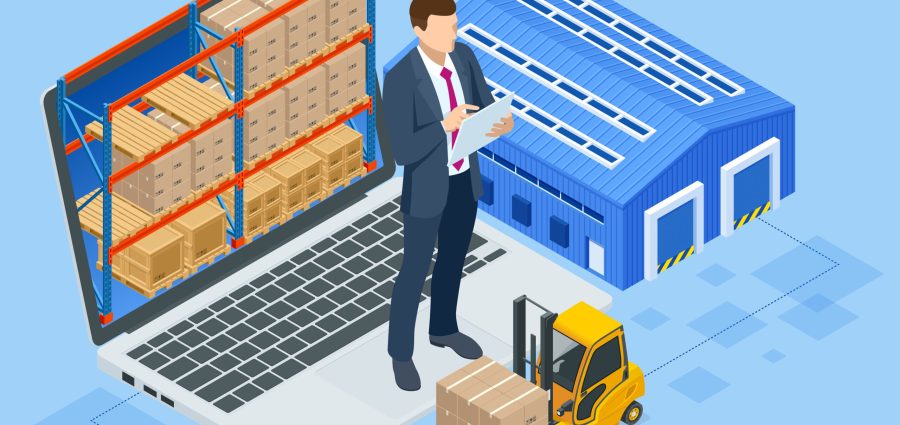Stockroom and service truck inventory managers looking to power through industry disruptions and still keep inventory well-stocked should meet today’s challenges head-on by collaborating with suppliers and using new technology. New approaches and technologies can result in real-time access to analytical data, better customer service, fewer inventory shortages, optimized inventory levels, strengthened supplier relationships and lowered inventory carrying costs.
To gain these benefits, inventory operators should take stock and rethink old ways of managing inventory. They should instead consider new automated technologies and methods to keep their stockrooms and service trucks filled with just the right inventory at the right time, and no more.
Peerless Research Group recently conducted a survey of operational factors at DCs and warehouses on behalf of Logistics Management and Modern Materials regarding concerns with warehouse operations and trends. The survey found that in 2021, warehouse operators faced issues with:
- Employment struggles
- Insufficient inventory space
- Inability to find and retain qualified supervisors
- Outdated equipment
- Challenges from increased e-commerce demands
The survey found that managers needed to find a way to control inventory as efficiently as possible in a time of supply and labor shortages. And respondents posited that applying more technology is the path forward.
Gartner recently released a report listing predictions for 2022 and outlining the need for organizations to adapt more quickly to ever-changing conditions with innovative technologies. They’ve identified that, in 2022, CEOs have three priorities: growth, digitalization, and efficiency.
For stockroom and service truck managers looking to reduce inventory shortages and eliminate excess inventory to free up space, IoT technologies like inventory sensor bins and electronic shelf labeling systems paired with automated replenishment apps are ideal innovative technologies. Without hiring additional labor, stockroom managers can easily track inventory consumption in real-time and automatically place orders for replenishment.
Here are several innovative technologies that can help stockroom managers meet today’s inventory management demands:
SensorBins for Remote Inventory Management and Replenishment
IoT weight sensors placed under bins of supplies can digitally track stock levels. Paired with a software app that converts bin weights to quantity, these sensors allow complete physical inventory counts multiple times a day without human intervention. The right sensors can measure weights as little as .1 grams to as large as 1,000 kilograms 2,200 lbs. Setting minimum and maximum inventory levels on the replenishment app allows the bins to detect when an item drops too low and automatically trigger a replenishment order.
Sensor bins enable inventory managers to:
- Ensure the parts are always in stock
- Reduce excess stock and storage space
- Remotely monitor inventory levels
- Set automated stock replenishment
- Better comply with COVID measures
- Attract and retain employees by reducing ‘grunt work’
Automation with sensor bins benefits suppliers and stockroom managers. This technology allows a supplier’s staff to do more selling and less accounting for products, while the stockroom managers can reduce both inventory levels and annual carrying costs in overstocked inventory and free up stockroom space.
Electronic Shelf Label (ESLs) Systems
Electronic Shelf Labels (ESLs) are digital labels that interact with users and distributors. Gaining use in the industrial sector, these labels are growing in popularity as IoT inventory management tools. ESLs reveal the most current information, such as pricing, on-hand quantities and re-orders in progress. They can also connect to other devices to trigger commands or provide consumption reports.
Predictive Planning and Demand Forecasting
Demand planning is a critical part of supply chain management, especially in times like these. Using an intelligent inventory app can help incorporate data on actual usage into decision-making. Modern demand planners are focused on stockroom needs and usage, rather than simply stocking products on shelves “just in case.” Collaborating with suppliers by using an automated stockroom replenishment app that provides visibility to both parties means suppliers can better respond to a stockroom manager’s expectations for quick and accurate replenishment.
With an unpredictable supply chain, IoT technologies that deliver “no-touch” physical inventory counts, optimized replenishment orders and analytics about stockroom and van inventory usage can help stockroom managers operate more efficiently without additional staff. The right digitalization solutions can provide better visibility into inventory levels for both suppliers and inventory managers and mitigate the effects of disruption while increasing productivity and growth.

Rock Rockwell is CEO of eTurns, a point-of-use inventory management app that automates inventory replenishment in stockroom and service trucks using phones, RFID and TrackStock SensorBins™. Contact Rockwell at rock@eturns.com.
Related Posts
-
The pandemic forced distributors to increase their online footprint to meet demands from customers; the…
-
The duo says the partnership boosts the value of Continental’s distributor network by making inventory…
-
John Gunderson has one of the most extensive networks across distribution verticals, including electrical, datacom,…





